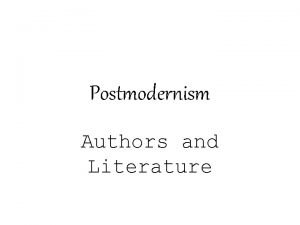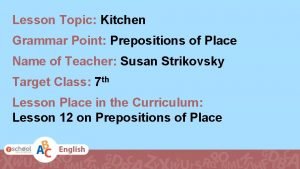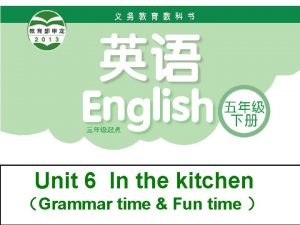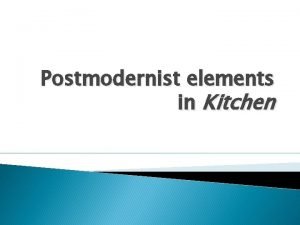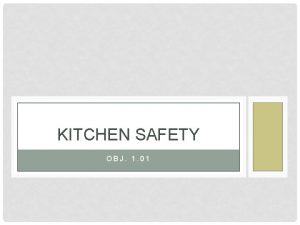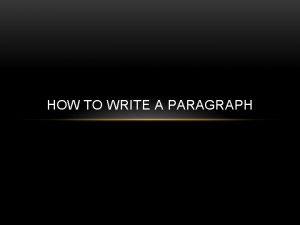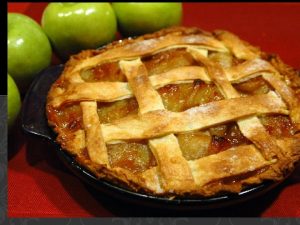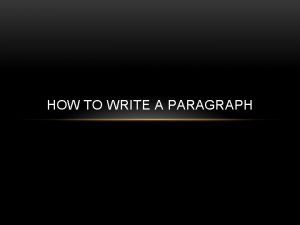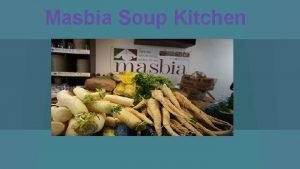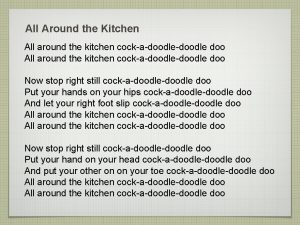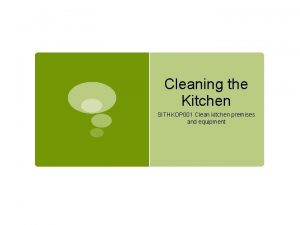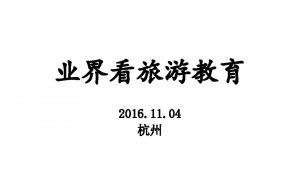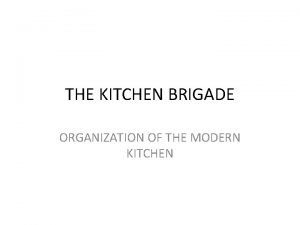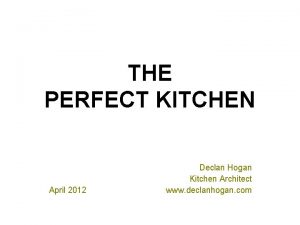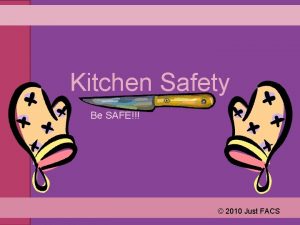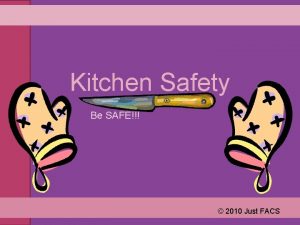Postmodernist elements in Kitchen The Paper 2 Paragraph






















- Slides: 22

Postmodernist elements in Kitchen

The Paper 2 Paragraph Topic (comparison embedded) Context Examples Ideas & Explanations Quotes Literary Devices Tie back to topic and compare texts

Modernism – post WW 1 to the 1950 s � In general, modernism is an early twentiethcentury artistic marked by the following characteristics: � (1) the desire to break away from established traditions, � (2) a quest to find fresh ways to view man's position or function in the universe, � (3) experiments in form and style, particularly with fragmentation--as opposed to the "organic" theories of literary unity appearing in the Romantic and Victorian periods.

Modernism vs. Postmodernism – 1950 s to now � “While modernism mourned the passing of unified cultural tradition, and wept for its demise in the ruined heap of civilization, so to speak, postmodernism tends to dance in the ruins and play with the fragments. ” in the case of Kitchen, does it reconstruct them into a new civilization? � Or

1. Postmodernism - Pastiche Pasted elements from other genres. Borrows from: � Shoujo manga � Magical Realism to Maus – both use pastiche in relation to the structure and style of each text. � Link

Shoujo Manga � Recognisable structure and style to the Shinjinrui generation as mass consumers of manga – their story in their genre CONTEXT � Androgynous characters in Shoujo – transgenderism manifested in the character of Eriko in ‘Kitchen’ and cross dressing in ‘Moonlight Shadow’ shown through Hiiragi.

Shoujo Manga Stylistic Devices Strongly influences the language style of the novella: Important information is conveyed succinctly and in a detached manner, like it is being reported with little descriptive, emotional detail “When my grandmother died the other day, I was taken by surprise. ” p. 4 � � Onomatoeipia creating strong visual and aural imagery “White light catching the light (ting!). ” p. 3 “Dingdong. Suddenly the doorbell rang. ” p. 5

Shoujo Manga – the illustrations converted to written sensual imagery Drawing pictures with words: � “I zoomed in for a closeup on his pupils. ” p. 6 CLOSE UP PANEL � “My gaze landed with a thud on the enormous sofa…” p. 8 ACTION � “I was inundated with the green smell of the night. ” p. 8 COLOUR

Postmodernism - Magical Realism � Arguably the most significant PM technique. � Dreams – Yuichi and Mikage have the same dream and “It was at once a miracle and the most natural thing in the world. ” p. 41 � Dreams – Satsuki dreams of Hitoshi every night and prefers her dreams to the life she must endure without him “…on awakening I would know it had only been a dream – in reality I would never be with him again. ” p. 112 � Spirit world where deceased characters return “Through the blue haze”, Satsuki sees the ghost of Hitoshi.

Motif of white - a symbol of the spirit world in Japan � � “No matter what, I want to continue living with the awareness that I will die. ” p. 59 THEME “(Yuichi) seemed to glow with white light. ” p. 7 - Elements of MR but conversely could foreshadow Eriko’s death. The “white bridge…divided our part of the city almost exactly in half. ” Symbolic of connection, link, overcoming adversity, meeting place. It is the place where Satsuki and Hitoshi met and departed in life, and where he meets her again in between the worlds of life and death. MR Urara, Satsuki’s guardian angel, “wore a thin white coat” and bought Satsuki a “little white…thermos”, symbolising her connection with the spirit world. MR

Shoujo and narrative focus � Shoujo focuses on the conflicts being psychological rather than physical. � Provides a platform for Yoshimoto and the audience to engage in existentialist ponderings – how to make meaning from the confusion of life. “Was that what in meant to be an adult, to live with ugly ambiguities? ” p. 56 � No physical intimacy between Yuichi and Mikage. Theirs is a meeting of minds. �-

2. Postmodernism- Participation � � The author allows the reader to create their own “truth”/meaning rather than insist on her/his authorial authority. The reader is allowed to have a “voice” in the way some elements are purposely vague/ absent to allow him/her to imagine whatever pleases him/her. Shoujo characters’ faces are relatively blank, reflecting the blandness of the characters so readers can project themselves onto them. Most characters in Kitchen are quite bland one dimensional, especially the protagonists Mikage and Satsuki, inviting the reader to project their views onto them and make meaning for themselves based on their individual context of interpretation.

2. Postmodernism- Participation � Link to Maus � Generic drawings of anthropomorphised animals. � Art wearing the mask and addressing the audience face on and directly.

3. Postmodernism - Pop culture In PM, every day experience is integrated and, thus, valued: � Linus from Peanuts in ‘Kitchen’ � “Like watching Bewitched” � KFC in ‘Moonlight Shadow’ � Consumerism – couch, juicer, word processor to Maus – the comic form-the entire novel is based on a pop culture genre. � Link

4. PM - Alternate Families as a non-conformist construct � Mikage’s first impression of the Tanabe’s apartment is that it was “truly strange”, foreshadowing the revelation about the family that lives there. � Yuichi tells Mikage that Eriko is “a man”, which “was too much” for Mikage initially. Transgenderism.

4. PM - Alternate Families as a non-conformist construct � She then moves in as part of a modern, unconventional family, a family predicated on acceptance and unconditional love as the primary values – a strong indicator of the shift by the Shinjinrui away from traditional values, “cheerfully normal in the midst of such extreme abnormality. ” � “Eriko was taken in by” another family, whose daughter he “eloped with”. Arguably, foreshadows Mikage and Yuichi’s relationship. P. 14 to Maus – opposite -traditional but highly dysfunctional family of Vladek, Mala, Art and the ever present ghosts of Richieu and Anja. � Link

Kitchen & Food motifs � First line of the novella -“The place I like best in this world is the kitchen. ” p. 1 “I want to breathe my last in a kitchen. ” p. 4 � Offers � Both Mikage emotional and physical nourishment. orphans in the world, Mikage and Yuichi reach out to each other in a subtle courting ritual that sees food as a motif for their growing attraction and commitment to each other, “satisfying hunger and lust at the same time”.

Kitchen & Food motifs � Mikage can say sincerely that she would “make carrot cakes that included a bit of my soul” and in the supermarket ”Stare at a bright red tomato, loving it for dear life. ” Her relationship with food defines her and her relationships in many ways. to Maus – As abundant as food is in Kitchen, the absence of food, or constant management of food for survival or bargaining, permeates the experiences of Anja and Vladek in Auschwitz. Food becomes a commodity rather than the sensual, emotional experience it is in Kitchen, as evidenced by Vladek returning the half eaten cornflakes for a refund at the supermarket. Seemingly, his Holocaust experiences have forever corrupted his enjoyment of food. � Link

1. WHY? Art reflects life – mimesis (imitation, representation) � Using post modernist elements enables Yoshimoto to redefine traditional Japanese storytelling to reflect the real world of the Shinjinrui generation, who were similarly redefining traditional Japan in the 1980’s. In this sense, the unique, distinctive style of the novella reflects the changing world it explores. to Maus – Maus uses mimesis to represent a version of the Holocaust in a highly unique and controversial form – the graphic novel based on the comic genre. � Link

2. WHY? Capturing the Zeitgeist The Zeitgeist (spirit of the age or spirit of the time) is the intellectual fashion or dominant school of thought that typifies and influences the culture of a particular period in time (Wikipedia)- Historic lens � In capturing the zeitgeist of 1980’s Japan, Yoshimoto gives legitimate voice to the concerns and changing values of the Shinjinrui which were significantly different to those of previous generations. In this sense, like The Great Gatsby, it is now a historical artefact of its time.

3. WHY? The Happiness Paradox � Yoshimoto acknowledges through many instances of death that “Life can be so hard. ” This is demonstrated through the significant, life altering loss so many of the young characters in Kitchen experience. Even so, Eriko notes that “if a person hasn’t experienced true despair, she grows old never knowing…what joy really is. ” p. 41 This suggests that humans must experience the paradox of knowing deep pain if they are to enjoy real happiness. � “I was puzzled, smiling about how I had just gone from the darkest despair to feeling wonderful. ” p. 35

3. WHY? Link to Maus – BUT…the opposite of the Happiness Paradox The characters in Maus are deeply damaged by the horrors of the Holocaust, with Anja suiciding, Vladek struggling with paranoia and Art suffering significant depression as a by-product of his parents’ trauma. Joy seems to elude them, suggesting that though humans have the capacity to bear some loss, as Mikage and Satsuki attest, loss on the scale of the Holocaust is beyond the limits of human emotional endurance, leaving little but pain and despair in its wake.
 Modernist vs postmodernist
Modernist vs postmodernist Postmodern british literature authors
Postmodern british literature authors Preposition of place kitchen
Preposition of place kitchen In the kitchen or at the kitchen grammar
In the kitchen or at the kitchen grammar Descriptive pargraph
Descriptive pargraph Spatial order sentence example
Spatial order sentence example Kitchen paragraph
Kitchen paragraph English general paper paper 2 comprehension
English general paper paper 2 comprehension General paper questions
General paper questions Hình ảnh bộ gõ cơ thể búng tay
Hình ảnh bộ gõ cơ thể búng tay Slidetodoc
Slidetodoc Bổ thể
Bổ thể Tỉ lệ cơ thể trẻ em
Tỉ lệ cơ thể trẻ em Chó sói
Chó sói Thang điểm glasgow
Thang điểm glasgow Bài hát chúa yêu trần thế alleluia
Bài hát chúa yêu trần thế alleluia Môn thể thao bắt đầu bằng từ chạy
Môn thể thao bắt đầu bằng từ chạy Thế nào là hệ số cao nhất
Thế nào là hệ số cao nhất Các châu lục và đại dương trên thế giới
Các châu lục và đại dương trên thế giới Công thức tính thế năng
Công thức tính thế năng Trời xanh đây là của chúng ta thể thơ
Trời xanh đây là của chúng ta thể thơ Cách giải mật thư tọa độ
Cách giải mật thư tọa độ Làm thế nào để 102-1=99
Làm thế nào để 102-1=99

